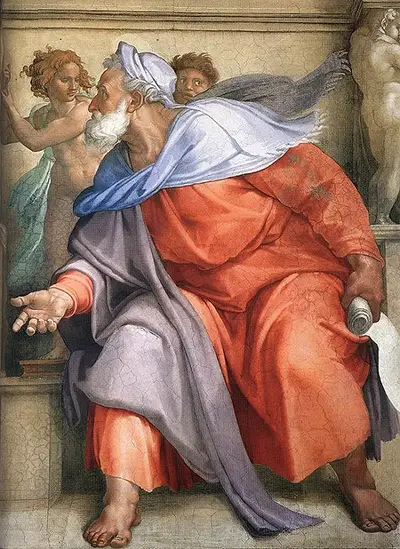Ezekiel was born circa 622 BC and died circa 570 BC.
Here he is depicted seated, addressing Zechariah to his right. The openness of his outstretched hand shows the surprise and wonderment of his vision. He is explaining all that he saw. The appearance of a man sitting upon a throne being supported by four creatures each had four different faces.
A face of a human being, and on the right side the face of a lion, and on the left an ox; each also had the face of an eagle. When he saw it he is said to have fallen face down and heard the word of god.
His message from god was one that predicted the violent fall of both Jerusalem and Judah. Therefore Ezekiel is warning the exiles about the coming destruction and he is making it clear that it is to happen as a punishment for their idolatry and distasteful behaviour.
Latterly the man was used as the symbol for Matthew, lion for Mark, the ox for Luke and the eagle for John, the writers of the gospels.
The Fresco style of painting used is the application of water-based pigments upon freshly applied plaster, most commonly upon wall or ceiling surfaces. Each colour is created by grinding dry-powder pigments with water and painting them upon the drying plaster. This ensures that the image painted will become a permanent part of the wall or ceiling.
Buon is the most long lasting fresco technique which consists of a process that includes three successive layers of specially prepared plaster, sand and upon occasion’s marble dust applied to the wall or ceiling. Next, the paint is applied and allowed to harden.
The artist would have previously made a full-scale copy of the originally finished drawing. In this case Ezekiel. He then copies the preparatory drawing onto the wall from a tracing made of the eventually finished image. Next, the fine smooth thin coat of plaster (intonaco) is then put onto the wall or ceiling but importantly, only as much as can be painted in one session.
Finally, the tracing is held up to the wall over the fresh final coat and lined up carefully with all the adjacent parts of the painted wall or ceiling and its contour and interior lines are traced onto the fresh plaster.
The Intonaco will hold its moisture for many hours allowing the artist not to have to work at unnatural speed. And upon drying the colours are absorbed into the surface as the wall or ceiling dries out and sets. This process gives the colours great stability and durability to be able to cope with the process of ageing.
An interesting aspect of this kind of painting is that the artist, although he must paint whilst the plaster, is damp before it dries out. The artist cannot correct mistakes by simply over painting. This has to be done later by a fresh coat of plaster called secco, where the paint is applied after mixing it with plaster.


